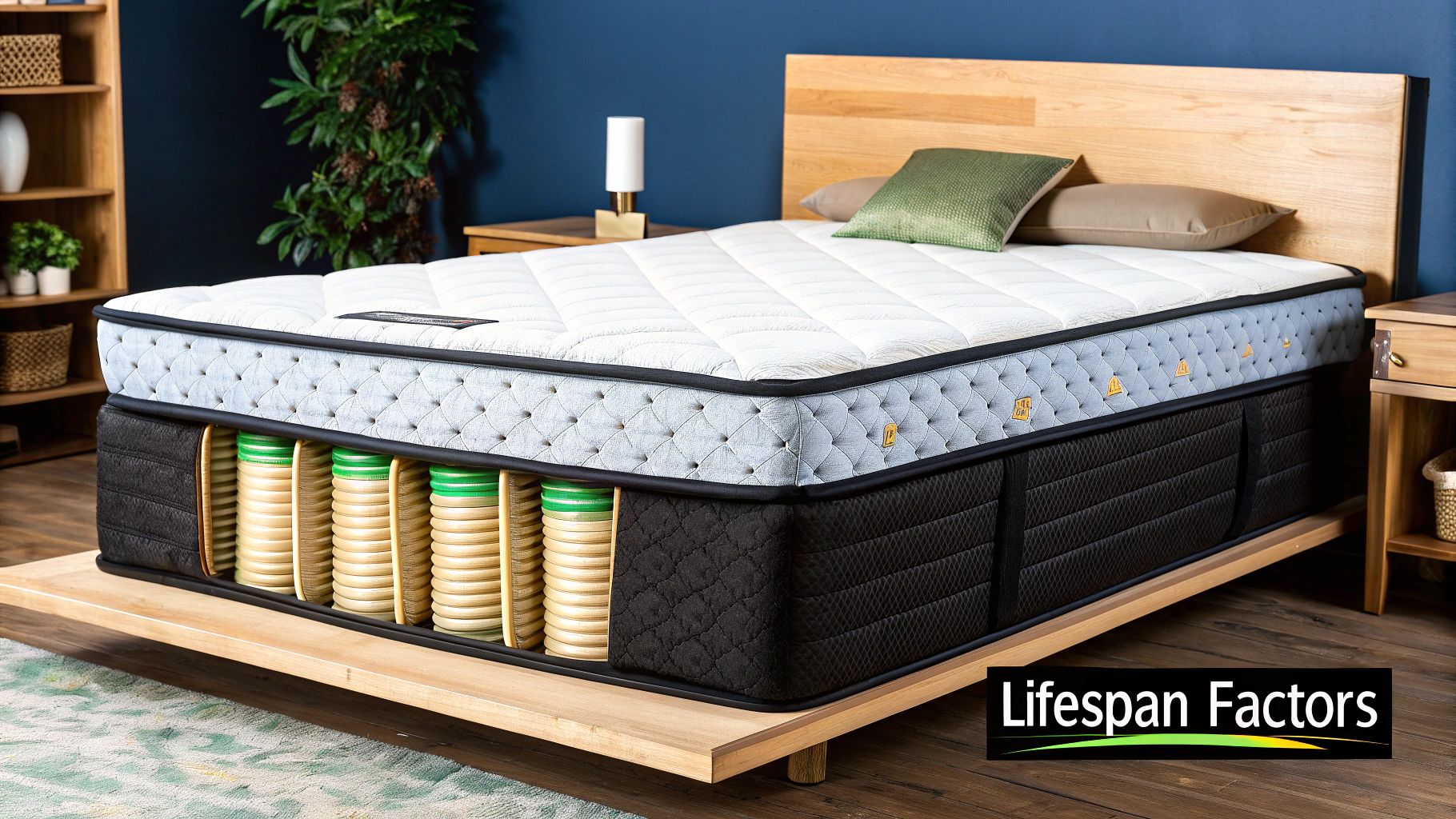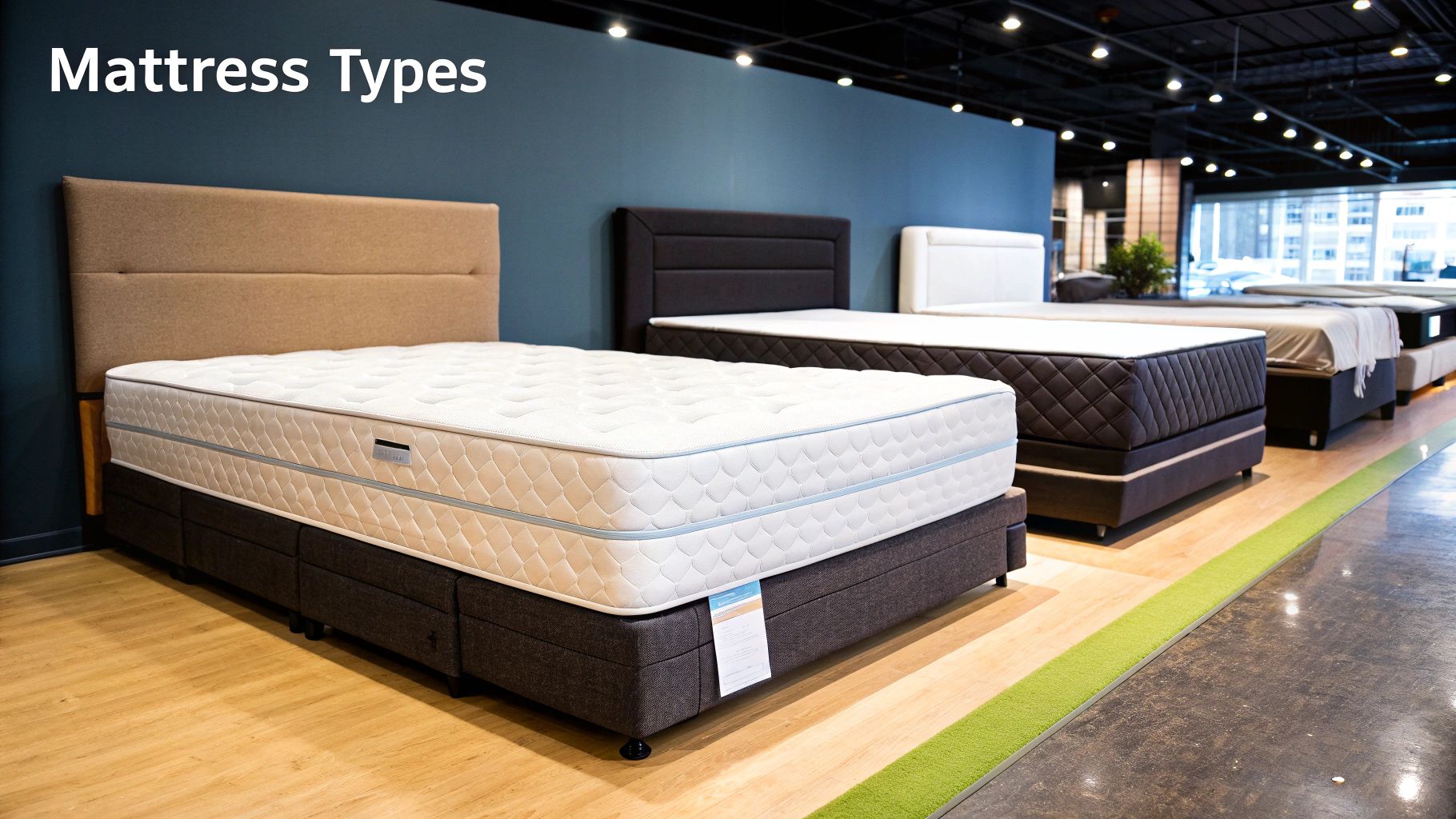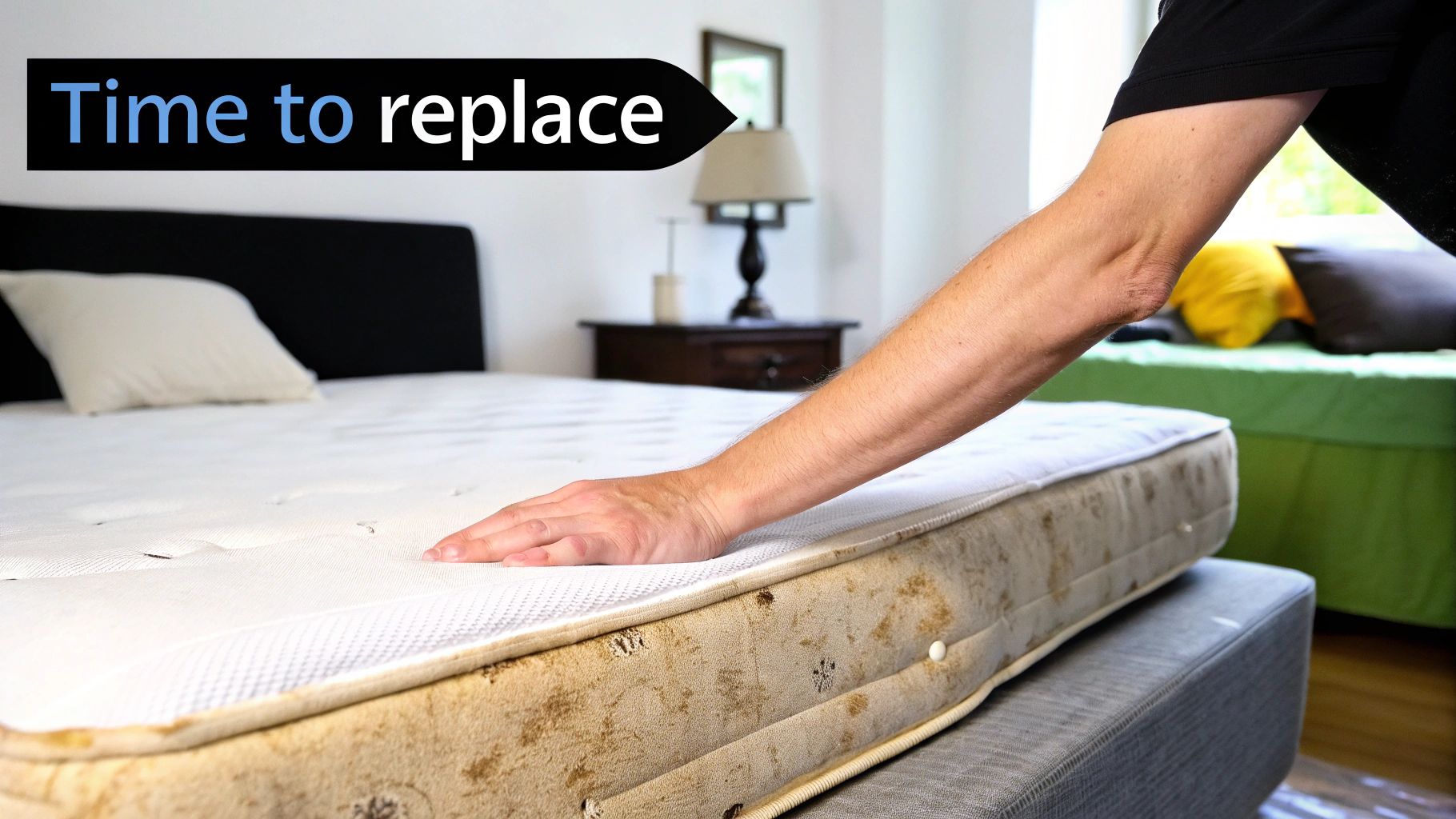Ever lie awake wondering, "how long should a mattress last?" You're not alone. While most sources quote a general rule of 7 to 10 years, the real answer is far more personal. The true lifespan of your bed depends heavily on its material, construction, and how you care for it.
Think of it this way: your mattress works hard for you every single night. Over thousands of hours, even the best materials begin to tire. Knowing how long mattresses should last helps you decide when it's time for an upgrade, ensuring you're always getting the restorative sleep you deserve. This guide breaks down everything you need to know, from material lifespans to the tell-tale signs that your bed is past its prime.
Your Quick Guide to Mattress Lifespans
Just like a pair of running shoes, not all mattresses are built for the same mileage. A basic, budget-friendly innerspring might serve a guest room well for a few years, but a high-quality latex mattress could easily provide over a decade of consistent comfort. The materials are the biggest clue to its longevity.
Here’s a simple breakdown of what to expect from the most common mattress types in Australia.
Average Mattress Lifespan by Type
| Mattress Type | Average Lifespan | Best For |
|---|---|---|
| Innerspring | 6-8 years | Budget-conscious shoppers, guest rooms |
| Memory Foam | 8-10 years | Side sleepers, couples (great motion isolation) |
| Latex | 12-15 years | Eco-conscious buyers, allergy sufferers, durability |
| Hybrid | 8-10 years | People who want the "best of both worlds" (coils + foam) |
As the chart shows, investing in premium materials like latex can significantly extend the life of your mattress, pushing back the need for a replacement. For a deeper dive, you can find more detail at Onebed.com.au.
The chart below offers another handy visual to help you compare.
What This Means For You
So, what's the bottom line? Don't get fixated on a single number. The 7-to-10-year window is a helpful guideline, but your body is the ultimate judge.
If you consistently wake up with a sore back or just can't get comfortable, it doesn't matter if your mattress is five years old or fifteen—it's time for a change.
The most important factor isn't the calendar age of your mattress, but the quality of sleep it provides. An older mattress that still offers great support is far better than a new one that leaves you tossing and turning.
Ultimately, you are the best judge. The next sections will walk you through the key signs that your mattress is past its prime and help you choose your next one wisely.
The Hidden Factors That Shorten Your Mattress Life

Knowing the mattress type gives you a ballpark figure, but it doesn't tell the whole story of how long a mattress should last. Two seemingly identical mattresses can have vastly different lifespans. This often comes down to a few key factors working behind the scenes.
Understanding these factors is key to getting the most out of your investment. Your body weight, sleeping style, and the "unseen" quality of the internal materials all play a huge role.
Your Body and Sleeping Style
It’s simple physics: the more weight a mattress supports each night, the harder it works. Over time, this pressure causes foams and springs to compress and lose their ability to bounce back. A mattress used by two larger adults will naturally experience more strain than one used by a single, lighter person.
Your preferred sleeping position also concentrates pressure on specific zones.
- Side sleepers place significant weight on their shoulders and hips, which can cause the mattress to soften and dip in those areas first.
- Back sleepers distribute their weight more evenly, which is generally kinder to the mattress surface.
- Stomach sleepers often put the most pressure on their lumbar region, leading to that dreaded sag in the middle of the bed.
This is why rotating your mattress regularly is so crucial—it helps distribute the wear and tear more evenly. For more tips on keeping your bed fresh, check out our guide on making your bedding last longer.
The Unseen Quality of Materials
Here’s a secret of the mattress industry: not all materials are created equal. Two memory foam mattresses might look similar, but their internal components can be worlds apart in quality.
Think of it like a kitchen sponge. A cheap, low-density sponge flattens out quickly, while a dense, high-quality one lasts for months. It’s the same with mattress foams.
High-density foams are more resilient and durable. A foam with a density of 2.5 kg/m³ or higher is a strong indicator of a long-lasting mattress.
It’s a similar story with innerspring or hybrid mattresses. The crucial factor is the coil gauge, which refers to the wire's thickness. A lower gauge number means a thicker, sturdier spring that will resist sagging for much longer. You can help protect these internal components with a good mattress topper. Learn more in our guide on when to replace your mattress topper.
The 7 Telltale Signs Your Mattress Is Expired

Sometimes the cause of your restless nights is hiding in plain sight: your worn-out mattress. Instead of just going by the calendar, listen to your body and pay attention to how your bed is performing. Here are seven clear signals that it's time for a replacement.
1. You Wake Up Sore and Stiff
This is the number-one sign. If you go to bed feeling fine but wake up with a stiff neck, sore back, or aching hips, your mattress is likely failing you. Over time, its materials break down, losing their ability to keep your spine in a healthy, neutral alignment.
Real-world example: A customer, Mark, couldn't figure out why his lower back was constantly aching in the mornings. It turned out his 8-year-old mattress had developed a subtle sag right under his hips. A new, more supportive mattress eliminated his morning pain within a week.
2. Your Allergies Are Flaring Up
Are you constantly stuffy or sneezing at night? An old mattress can become a breeding ground for dust mites, mould, and other allergens. These microscopic irritants accumulate deep inside the mattress layers over the years.
In fact, a study from Ohio State University found that a used mattress can contain anywhere from 100,000 to 10 million dust mites. If your allergy symptoms are worse in the morning, your bed is a likely culprit.
3. It’s Noticeably Lumpy or Sagging
This one is easy to check. Strip the sheets off your bed and look at the surface. Can you see a distinct crater where you sleep? Run your hand firmly across it. If you feel lumps, bumps, or deep indentations, the internal support layers have given up.
A visible dip of more than 4 centimetres is a dead giveaway. It means the structural integrity is compromised, and you're no longer getting the even support needed for proper rest.
An uneven surface makes it impossible to find a comfortable position. Even the best mattress topper can't fix this fundamental problem; learn more in our guide on the five signs it's time to replace your mattress topper.
4. You Can Hear It Groaning and Creaking
Your bed should be a silent sanctuary. If every small movement is met with a chorus of squeaks, creaks, and groans, it’s a bad sign. This noise indicates that the springs and coils inside are worn out and have lost their resilience. It’s your mattress audibly asking for retirement.
How to Make Your Mattress Last Years Longer

A great mattress is an investment in your health, so it makes sense to protect it. While you can't stop the clock, a little regular care can go a long way in preserving its comfort and support, often adding years to its lifespan.
Start with a Quality Mattress Protector
This is the single most effective thing you can do. A high-quality, waterproof mattress protector acts as a shield against the elements that slowly degrade mattress materials.
A good protector creates a barrier against:
- Moisture: Spills, sweat, and humidity can encourage mould and break down foams.
- Allergens: It stops dust mites, dead skin cells, and pet dander from settling deep inside your mattress.
- Stains: An accidental spill can void your warranty, so keeping the surface clean is vital.
Rotate Your Mattress for Even Wear
We all have a preferred sleeping spot, which means one area of the mattress gets more use. This leads to uneven wear, dips, and soft spots over time. The solution is simple: regular rotation.
Turning your mattress 180 degrees every three to six months spreads the wear and tear evenly across the surface. This simple habit prevents premature sagging and can add years to its supportive life.
Most modern mattresses are designed to be rotated, not flipped, due to their layered construction.
Provide a Solid Foundation
The base your mattress sits on is more important than you might think. A weak, old, or sagging base provides uneven support, which can cause a brand-new mattress to bow and wear out quickly.
Ensure your mattress has a sturdy foundation, such as a slatted base (with slats no more than 7 cm apart) or a solid platform. Proper support is essential for your mattress to perform at its best.
For more advice, check out our guide on 6 ways to make your bedding last longer.
Why Aussies Are Replacing Mattresses Sooner
https://www.youtube.com/embed/HTvmlWa2JlM
Does it seem like everyone is getting a new mattress? You're not wrong. The old approach of keeping a mattress until the springs poke through is fading. Today, Australians are prioritising sleep quality, which is changing how long we expect a mattress to last.
This shift comes from a better understanding of how vital sleep is for our overall health. We no longer just want something to lie on; we want a clean, supportive environment that helps us recharge.
A Growing Focus on Sleep Health
We are more aware than ever of the link between quality sleep and mental focus, mood, and physical health. This knowledge has changed our expectations. We now realise an old, sagging mattress can be the direct cause of morning aches, a stiff back, or even a bad mood.
Because of this, we're quicker to replace a bed that isn't performing, rather than waiting for it to become unbearable. It’s an investment in your health, just like a gym membership.
The modern mindset is simple: if your mattress is interfering with good sleep, it's time for it to go—regardless of its age. Comfort and support now trump longevity.
Lifestyle and Market Changes
Other factors are also speeding up this replacement cycle. The "bed-in-a-box" revolution has made buying a new mattress incredibly easy and affordable, removing much of the traditional hassle.
Our lifestyles are also more mobile. People move house more often, and a move is the perfect opportunity to ditch a heavy, old mattress and start fresh.
The numbers back this up. On average, Australians now replace their mattresses every 8.9 years, down from 10.3 years a decade ago. To get more insight, you can explore detailed sleep advice on AHBeard.com. This trend clearly shows a prioritisation of performance and hygiene over sheer lifespan.
Choosing Your Next Durable Mattress
Ready for an upgrade? Knowing how long mattresses should last is one thing, but picking a new one built for durability is another challenge. With a bit of knowledge, you can confidently find a bed that will provide years of quality sleep.
Ask specific questions. Inquire about the foam density (measured in kg/m³)—a higher number means more resilient foam. For innerspring or hybrid models, ask about the coil count and gauge. More coils and a lower gauge (thicker wire) indicate a stronger, more supportive core.
Matching a Mattress to Your Needs
Choosing the right type of mattress for your body and sleeping style is crucial for longevity. Each material offers a different balance of comfort, support, and durability.
- For Allergy Sufferers: Natural latex is hypoallergenic and highly resistant to dust mites. It's also one of the most durable materials available.
- For Back Pain: A quality hybrid mattress often provides the best of both worlds: pressure-relieving foam combined with the solid spinal alignment of a robust coil system.
- For Active Sleepers: Memory foam excels at isolating motion, so you're less likely to be disturbed by a restless partner.
It's worth remembering that a warranty covers manufacturing defects—like a broken coil or extreme premature sagging. It won't cover the natural softening that occurs over time from normal use.
Ultimately, finding the mattress that fits you is what matters most. For a deeper dive, it’s well worth reading up on how to choose the best mattress for your needs.
Your Questions About Mattress Lifespan, Answered
Here are straight-to-the-point answers to the most common questions we hear about how long a mattress should last.
Does a Warranty Guarantee How Long It Lasts?
Not really. A warranty is a safety net against manufacturing defects, like a broken spring or a dramatic, premature sag. It isn't designed to cover the natural softening and gradual loss of comfort that happens with nightly use. Think of it as insurance against a faulty product, not a promise of a decade of perfect sleep.
Can a Topper Fix My Old Mattress?
A mattress topper can add a temporary layer of comfort, but it’s a band-aid solution. If your mattress is already sagging or lumpy, a topper will simply conform to those dips. It masks the problem without solving the core issue: a lack of foundational support.
How Do I Dispose of My Old Mattress in Australia?
Disposing of an old mattress responsibly is important. Most local councils offer scheduled hard rubbish collections, so check their website for dates and rules. For an eco-friendly option, services like Soft Landing recycle up to 75% of mattress components, keeping them out of landfill. For more information, check out our detailed FAQs page.
Time for a Better Night's Sleep?
If your mattress is showing its age, it's time to invest in your wellbeing. A quality mattress isn't a luxury; it's the foundation of a healthy lifestyle. Don't settle for restless nights and morning aches.
Ready to find a mattress that’s built for lasting comfort and support? Explore the luxurious and durable bedding collection at Sienna Living and discover the difference a quality foundation can make. Visit us at https://www.siennaliving.com.au to find your perfect match today.

